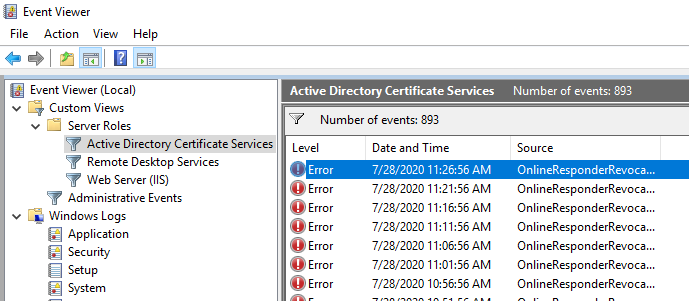Nachfolgend eine Übersicht über die vom Onlineresponder (OCSP) erzeugten Ereignisse in der Windows-Ereignisanzeige.
Die Ereignisse des Onlineresponders sind nicht offiziell dokumentiert. Die nachfolgende Liste wurde mit Hilfe des Tools Windows Event Log Messages (WELM) erzeugt.
Der Online Responder (Online Certificate Status Protocol, OCSP) ist eine alternative Möglichkeit, Sperrstatusinformationen für Zertifikate bereitzustellen. Entitäten, die den Sperrstatus eines Zertifikats überprüfen möchten, müssen dank OCSP nicht die komplette Liste aller widerrufenen Zertifikate herunterladen, sondern können gezielt eine Anfrage für das betreffende Zertifikat an den Online Responder stellen. Für eine detailliertere Beschreibung siehe Artikel "Grundlagen Online Responder (Online Certificate Status Protocol, OCSP)".
Ereignisquellen
Die Ereignisse des Onlineresponders werden in das Anwendungs-Protokoll geschrieben. Folgende Quellen enthalten OCSP-Ereignisse:
- OnlineResponder
- OnlineResponderRevocationProvider (Microsoft-Windows-OnlineResponderRevocationProvider)
- OnlineResponderWebProxy
Vordefinierte Ansicht in der Windows-Ereignisanzeige
Eine entsprechend gefilterte Ansicht ist in der Kategorie "Active Directory Certificate Services" auf jedem System, auf dem der Onlineresponder installiert ist, bereits vorkonfiguriert.

Ereignisquelle Microsoft-Windows-OnlineResponder
Kennen Sie TameMyCerts? TameMyCerts ist ein Add-On für die Microsoft Zertifizierungsstelle (Active Directory Certificate Services). Es erweitert die Funktion der Zertifizierungsstelle und ermöglicht die Anwendung von Regelwerken, um die sichere Automatisierung von Zertifikat-Ausstellungen zu realisieren. TameMyCerts ist einzigartig im Microsoft-Ökosystem, hat sich bereits in unzähligen Unternehmen auf der ganzen Welt bewährt und steht unter einer freien Lizenz. Es kann über GitHub heruntergeladen und kostenlos verwendet werden. Professionelle Wartung wird ebenfalls angeboten.
| ID | Typ | Ereignistext |
|---|---|---|
| 17 | Information | Online Responder Service was started. |
| 18 | Information | Online Responder Service was stopped. |
| 20 | Fehler | The Online Responder Service did not start: %1. |
| 21 | Fehler | %1: The Online Responder Service detected an exception at address %2. Flags = %3. The exception is %4. |
| 22 | Fehler | OCSP Responder Services did not process an extremely long request from %1. This may indicate a denial-of-service attack. If the request was rejected in error, modify the MaxIncomingMessageSize property for the service. Unless exhaustive logging is enabled, this error will only be logged every 20 minutes. |
| 23 | Fehler | The Online Responder Service could not locate a signing certificate for configuration %1.(%2) |
| 24 | Information | The Online Responder Service successfully (re)loaded a signing certificate for configuration %1. |
| 25 | Warnung | The signing certificate for Online Responder configuration %1 will expire soon. |
| 26 | Fehler | The signing certificate for Online Responder configuration %1 has expired. OCSP requests for this configuration will be rejected. |
| 27 | Warnung | The signing certificate for Online Responder configuration %1 was not updated.(%2) |
| 28 | Information | The signing certificate for Online Responder configuration %1 has been renewed. The hash for the new certificate can be located in additional data. |
| 29 | Fehler | Settings for Online Responder configuration %1 cannot be loaded. OCSP requests for this configuration will be rejected.(%2) |
| 31 | Warnung | Performance counters for the Online Responder Service cannot be initialized. |
| 32 | Information | The Online Responder Service detected a change in the signing certificate template version for configuration %1. The old version was (%2,%3), the new version is (%4,%5). |
| 33 | Fehler | The Online Responder Service failed to create an enrollment request for the signing certificate template %2 for configuration %1.(%3) |
| 34 | Fehler | The Online Responder Service encountered an error while submitting the enrollment request for configuration %1 to certification authority %2. The request ID is %3.(%4) |
| 35 | Fehler | The Online Responder Service failed to install the enrollment response for configuration %1 for the signing certificate template %2 . The request ID is %3.(%4) |
| 36 | Information | The Online Responder Service successfully enrolled for a new signing certificate for configuration %1. The new certificate’s hash can be located in additional data. |
| 37 | Warnung | The signing certificate for Online Responder configuration %1 does not include the mandatory OCSP No Revocation Checking extension. You must configure an OCSP Response Signing certificate template to include this extension in all OCSP Response Signing certificates. For more information, see Configure a CA to Support OCSP Responders in the Online Responder console Help. |
Ereignisquelle Microsoft-Windows-OnlineResponderRevocationProvider
| ID | Typ | Ereignistext |
|---|---|---|
| 16 | Warnung | For configuration %1, Online Responder revocation provider failed to update the CRL Information: %2. |
| 17 | Fehler | For configuration %1, Online Responder revocation provider either has no CRL information or has stale CRL information. |
| 18 | Fehler | For configuration %1, Online Responder revocation provider found a delta CRL referring to a newer Base CRL. |
Ereignisquelle Microsoft-Windows-OnlineResponderWebProxy
| ID | Typ | Ereignistext |
|---|---|---|
| 17 | Fehler | The Online Responder web proxy failed to Initialize. %1 |
| 18 | Information | The Online Responder web proxy is successfully loaded. |
| 19 | Information | The Online Responder web proxy is unloaded. |
| 20 | Information | The Online Responder web proxy detected an invalid configuration for the %1 property. The value was changed from %2 to %3. |
| 21 | Fehler | The Online Responder web proxy did not process an extremely long request from %1. This may indicate a denial-of-service attack. If the request was rejected in error, modify the MaxIncomingMessageSize property for the service. This error will only be logged every 20 minutes. |
Weiterführende Links:
- Übersicht über die von der Zertifizierungsstelle generierten Windows-Ereignisse
- Übersicht über die vom Registrierungsdienst für Netzwerkgeräte (NDES) generierten Windows-Ereignisse
- Übersicht über die vom Zertifikatregistrierungs-Richtliniendienst (CEP) generierten Windows-Ereignisse
- Übersicht über die vom Zertifikatregistrierungs-Webdienst (CES) generierten Windows-Ereignisse
Externe Quellen
- Windows Event Log Messages (WELM) (GitHub)
Ein Gedanke zu „Übersicht über die vom Onlineresponder (OCSP) generierten Windows-Ereignisse“
Kommentare sind geschlossen.